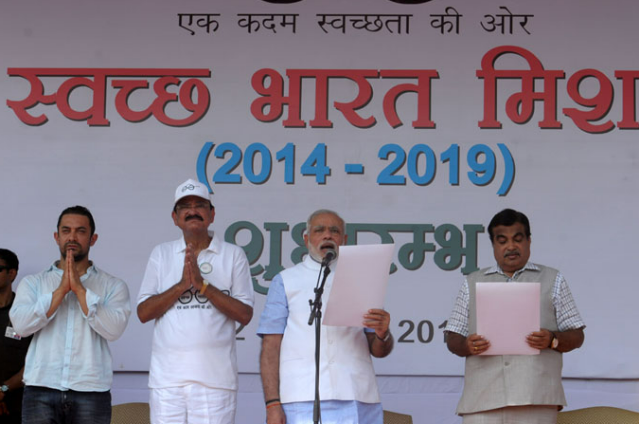“Cleanliness is near to Godliness” – M. K. Gandhi’s vision regarding a clean India was not a mere dream for him.
It was on Oct 2nd, 2014, that our Prime Minister Narendra Modi launched Swacch Bharat Abhiyan, or the Clean India Mission. Though India has seen a steep economical development, there are some areas where India seems to be underdeveloped, especially in case of health care and sanitation facilities. This deficiency has contributed to a decline of GDP by 4.2 %, owing to expenses in cases of various treatments and medicine. Proper health care and sanitation facilities' awareness regarding harmful effects of open defecation, and so on are some of the solutions to the issue. It was at Rajghat, on Oct 2 that Mr. Modi launched the scheme so as to make India clean and hygienic by 2019, as a tribute to Gandhi’s vision.
The key objectives of the scheme lie in improving health and sanitary conditions. It is run in two missions – Swacch Bharat Abhiyan ( Urban) administered by the Ministry of Urban Development and planning and Swacch Bharat Abhiyan ( rural) by the Ministry of Drinking water and sanitation. An estimated fund of Rs 62000 crore is being spent with additional Rs 14000 crore from state Governments contributing towards the Project. The main activities in the plan include increasing toilets from 3% to 10%; the community and public latrine and toilets are being increased from 14000 to 48000 throughout the country. It also takes initiatives to arrange awareness programmes among people regarding the harmful effects of neglecting health care and sanitation.
More than 60 per cent of India is covered as rural. Rural areas lack proper toilet facilities which contribute to people going on excreting on fields and roads. This leads to harmful hygienic conditions. The lack of planned and infrastructural arrangements regarding the proper disposal of liquid and solid waste is also a major concern. People are to be inspired to come forward and start cleaning their own areas, so as to obtain results.
The swacchta campaign has been promoted by various Filmstars, sportspeople and other emminent personalities. The recent past shows many schemes that have not been able to project and produce desired outcomes. Many were due to a lack of developers to make them available to commoners, mainly rural. The targeted beneficiaries were unable to avail themselves due to a lack of knowledge and awareness. But Swacch Bharat Abhiyan shows a high spread among rural, urban and towns. The support of common citizens, NGOs, civil society and corporations have helped to produce a good result.
The swacch Tha has been extended towards Ganga cleaning plans, road and other transportation facility improvement also. More than 110 waterways have been nationalised. Environment-friendly, pollution-less fuels like methanol, CNG, etc have been used instead of petrol and diesel. Efficient use of waterways has been popularized. Also related to Ganga Action Plan which takes action toward cleaning the highly polluted Ganga river. The steady growth of urbanization and industrialization has led to the polluting of the Ganges by the discharge of effluents from industry, affecting flora and fauna. Cleaning programmes have been carried out by the Ministry of River development and Rejuvenating Ganga.
The implementation of the scheme has brought about many changes and improvements. Proper sanitation and health care facilities have bought about the decline in death rates. It has also led to a decrease in susceptibility of people towards diseases like cholera, typhoid, vomiting, diarrhea and other vector-spreading and water-borne diseases. The population of people taking hospital treatment and the cost spent on medicines has declined drastically. The scheme is like a preventive health care scheme. Who suggests that about 3 lakh lives of people were saved from death due to being susceptible to various diseases, mainly water-borne diseases by 40 %.
The scheme has shown the participation of women to a large extent. There has been active participation of women in rural, urban, and towns, in Swacchtha rallies, awareness programme organizations, cleaning towns, etc. The scheme has also been able to make steady livelihoods to many informal workers like rag pickers by providing job opportunities in the various waste disposal and management actions. The rural life standard has seen a drastic change after the implementation of the scheme.
“Only when you fake the broom with your hand and start cleaning yourselves, will the cities start becoming clean”, as said by M. K. Gandhi. People participation has seen transparently yielding better results.
Many cities have been declared open defecation-free (ODF). Among the top 50 cities which are cleaner includes Gujarat with 12 cities, Madhya Pradesh with 11, Tamil Nadu, and Telangana with 5 each. Indore of Maharashtra is the cleanest city. The scheme targeted 4041 statutory towns and cities as beneficiaries. 118 cities of the 500 have been made 100 % toilet facilities availing. The components of urban implementation included household toilets, community toilets, public toilets, awareness rallies, and campaigns. Geotagging of toilets was also carried out. This was to ensure that proper construction was carried out as well as ensuring usage by the public. The Geotagging is similar to Aadhar biometrication. Toilets were numbered, photographed, the expense of usage noted, and so on. The swacchagrah is from various regions successfully contributed towards turning 70 % of India open defecation free.
The scheme was most inspirational to other countries all over the world, where they began implementing similar schemes. Mr. Narendra Modi has been awarded the ‘Global Goalkeeper’ award in New York. India was able to turn into a better, cleaner, and greener India within a short span of time until today. Whole-hearted participation of citizens is further expected so as to ensure a greener, cleaner, and 100 % defecation-free India.

